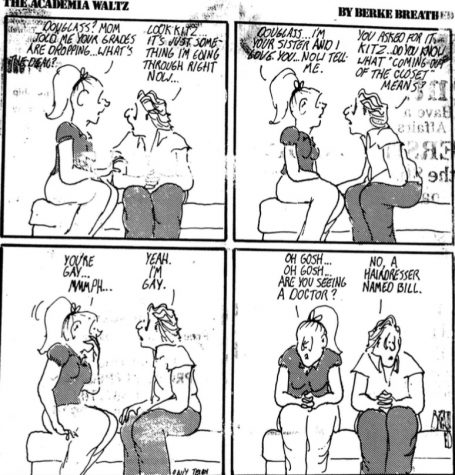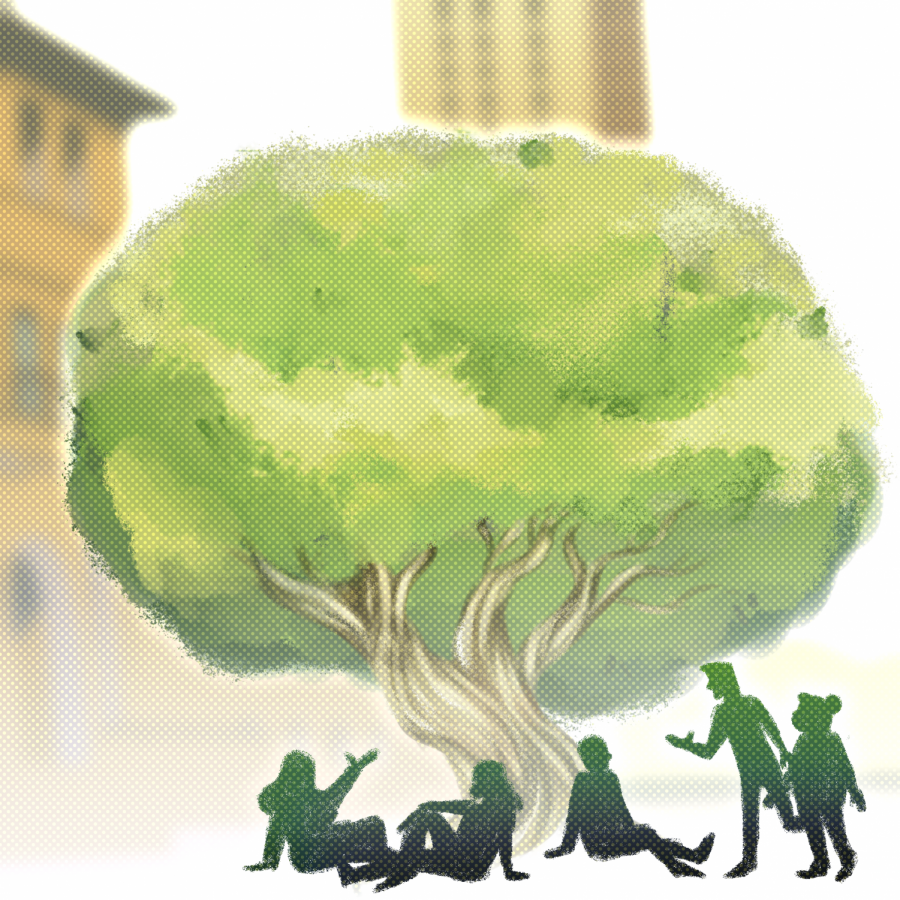Campus activists serve as roots of Gender and Sexuality Center
November 1, 2021
In 1992, Lisa Moore — the first openly lesbian professor at UT — returned to her office to find it broken into and vandalized.
“Someone pulled all the queer posters off the walls and set a bonfire on my desk and scribbled with marker on my windows ‘depravity kills’ 16 times, one in each of the little panes of those small Parlin windows,” Moore said.
While Moore said her home department and peers supported her, the professor said she also received objections from students and faculty.
“There was an editorial in The Daily Texan that said since I’ve been hired by the English department, it was now nothing more than a department of lesbian and socialists studies,” Moore said.
Moore, who now directs the University’s LGBTQ Studies Program, said campus has started to accept UT’s queer community with time but work remains to be done. She said the community has experienced discrimination on campus for decades.
“The visibility of queer people on the UT campus goes back to the 1940s,” Moore said. “There was a president of the University, Homer Rainey, … who was fired by the Board of Regents, because he was basically considered too liberal.”
Former President Rainey faced pressure from the regents and fired eight professors for being gay, but the Board blamed him for hiring them in the first place and claimed he should have dismissed them sooner.
A safe space
Moore said the vibrant Civil Rights and Women’s Rights movements at the University in the 1960s led to a push for queer rights on campus.
“Campus was actually a pretty early uptake of the sort of nationwide visibility of queer activism that happened after the Stonewall Rebellion in 1969,” Moore said. “There was a gay student union here in 1970 or ‘71, which was much earlier than other places in the south.”
With increased visibility of LGBTQ+ students came increased demand for a LGBTQ+ space on campus, said Liz Elsen, director of UT’s Gender and Sexuality Center.
“Students were fighting for the space for years,” Elsen said. “There were certainly people in Student Government (who) were working on it for longer, (and) absolutely, there has been push back throughout the history of UT.”
The University’s Gender and Sexuality Center launched in 2004 after the separately established Women’s Resource Center and GLBTA Agency merged in 2002.
Today, the center serves as a safe space for LGBTQ+ students on campus and strives to meet their needs through education, outreach and advocacy. The center’s creation was a culmination of years of activism as LGBTQ+ students and faculty struggled to feel a sense of belonging on a campus that historically underserved and ignored them.
Shane Whalley, a social work adjunct assistant professor, said the center provides a place of respite and comfort for LGBTQ+ students on campus while also providing a space for allies to learn about LGBTQ+ issues and join the fight.
“Campus for marginalized students is kind of like a giant game of tag,” Whalley said. “It’s like you run, you play with others, and then you want to go, be in home base, rest and refuel so you can go back out and play tag.”
When alumnus Ryan Miller first tried to locate the center, he couldn’t find the office, which was tucked away in a small closet in the Student Services Building.
“The first time I went to try to go to the GSC, I ended up going right out the door,” Miller said. “That’s how easy it was to miss. It was such a small space.”
A history of hostility
When alumni Ron Bowdoin attended the University as an undergraduate in 1971, he felt he was drowning in a sea of people who couldn’t understand his identity.
In his freshman year, he said he admired two men who lived near him and dressed in colorful boas and clothing when going out on the weekend. Bowdoin felt they were more themselves than he could ever be — but he also remembers seeing another resident heckle them.
“Somebody caught a glimpse of them and completely started to verbally abuse them,” Bowdoin said. “I knew immediately: I’m not safe here, I cannot be out, I cannot say anything about who I am in this environment.”
Bowdoin said in the 1970s, there were no centers or resources for him to access as a student belonging to the LGBTQ+ community, but he did remember a comic in The Daily Texan, which depicted a gay character. He said it made him feel seen.

“It was one of those sorts of glimpses that there are people out there who know who we are, where we are, what we’re going through … even in a humorous way,” Bowdoin said.
Establishing roots, literally and figuratively
Bowdoin attended UT again in the 1990s to complete his degree. That time, Bowdoin said LGBTQ+ students on campus met around a tree outside the Texas Union to find a semblance of community.
“The Gay Tree,” as it was called by students at the time, was an informal Gender and Sexuality Center: a place where LGBTQ+ students could belong, Bowdoin said.
“By this time, there were treatments for HIV and AIDS coming around,” Bowdoin said. “The (epidemic) was slowly, very slowly kind of winding down, so there was kind of hope on the horizon, healthwise.”
When Miller attended UT in the early 2000s, he worked as a student assistant at the center and helped to create the Queer Student Alliance, which is now the Queer Trans Student Alliance. In 2006, Miller and other QSA members published a report entitled “The State of Lesbian, Gay, Bisexual, Transgender, Queer Affairs at UT.”
“The QSA report caused a lot of departments to sit up and take notice,” Miller said. “Of not just saying they were allies, but sort of putting their money where their mouth is. Forcing them to think about what are they actively doing that is inclusive of or not inclusive of LGBTQ students.”
In the report, QSA asked for gender-neutral restrooms in all University buildings, updated staff training on the needs of LGBTQ+ students and the formation of a committee of students to advise administration on the needs of LGBTQ+ students.
“…We’re going to keep fighting and we’re not going to give up.”
The students also stressed how important the GSC was for the campus community as a whole and asked for increased funding of the center which at the time, had only two full time staff members.
Adrienne Hunter, radio-television-film, anthropology, and women’s and gender studies senior said when she read the original report a year ago that she noticed that many of the recommendations outlined still aren’t implemented on campus today. The University still does not offer gender-inclusive housing and many buildings on campus don’t have gender neutral bathrooms.
“There were still so many problems that needed to be addressed,” Hunter said. “Given the fact that there were a lot of problems that no longer existed but a lot of new problems, … there could possibly be a need for an updated report.”
Inspired by Miller’s 2006 report, in July of 2020, Hunter and her peers began work on an up-to-date report of LGBTQ+ affairs on campus. The report is set to publish next month and will vouch for increased inclusivity on campus. Along with the report, the team conducted a campus survey to gauge the feelings of students on the state of LGBTQ+ affairs on campus. The survey received over 2,300 responses.
“Overwhelmingly, students are very satisfied with the Gender and Sexuality Center,” Hunter said “That being said, students agree that the Gender and Sexuality Center does not have the space nor the resources that they need to meet the needs of LGBTQ+ students. And that’s a trend that’s seen over and over.”
Hunter said that while visibility for the LGBTQ+ community on campus has grown over time, this visibility is less apparent for trans students in particular, because there is still a stigma associated with being trans.
Psychology sophomore Indigo Giles, said this stigma contributes to the recent anti-trans legislation in the state legislature. They have continued the ongoing fight for LGBTQ+ rights, testifying at the Texas Legislature against multiple anti-transgender student bills.
“Hate is derived from fear and fear is derived from ignorance, so we hate things that we fear and we fear the things that we don’t understand,” Giles said. “A lot of these hateful bills … are directly tied to just a lack of information and a lack of education. If there was more education out there for cis students and cis faculty members, … there wouldn’t be as many of these issues.”
House Bill 25, which restricts trans student athletes from competing in sports as their identified gender, passed in both the House and Senate and was sent to Gov. Greg Abbott’s desk mid-October. Over 30 anti-LGBTQ+ bills filed this year were killed, but Giles said the abundance of anti-trans legislation in this session has caused increased calls to queer suicide and crisis hotlines.
While the University has come a long way since Moore was first hired, she, along with Whalley, Hunter, Giles and other members of the LGBTQ+ community on campus, said equality is still a long way from being achieved.
“No matter what happens, … we’re going to keep fighting and we’re not going to give up,” Giles said. “Partly because, like, what else can you do? But partly because we have each other’s back that much. And we’re not going to let this one setback push us into darkness.”



